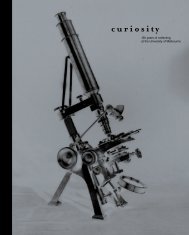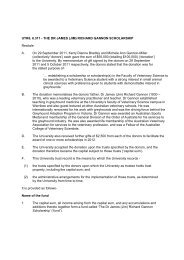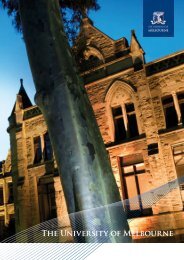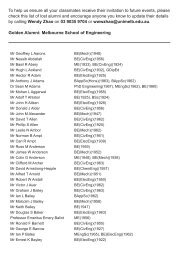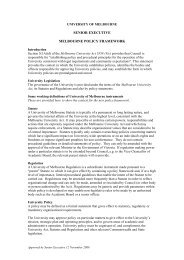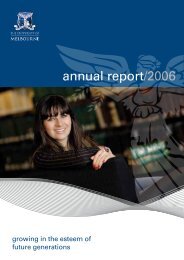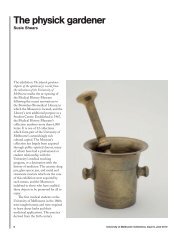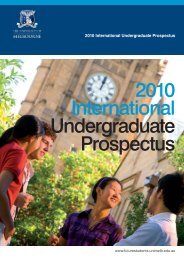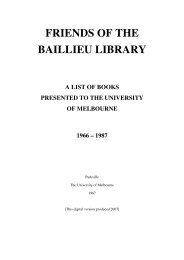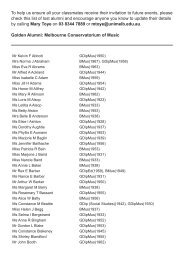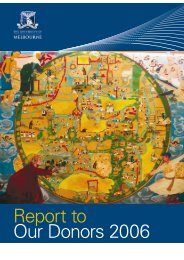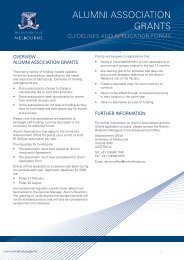News from the collections - University of Melbourne
News from the collections - University of Melbourne
News from the collections - University of Melbourne
You also want an ePaper? Increase the reach of your titles
YUMPU automatically turns print PDFs into web optimized ePapers that Google loves.
<strong>News</strong> <strong>from</strong> <strong>the</strong> <strong>collections</strong><br />
David and Marion Adams<br />
Collection<br />
Wednesday 15 April 2009 was an<br />
auspicious occasion for <strong>the</strong><br />
<strong>University</strong>’s Classics and Archaeology<br />
Collection. A function at <strong>the</strong> Ian<br />
Potter Museum <strong>of</strong> Art celebrated <strong>the</strong><br />
gift <strong>of</strong> <strong>the</strong> David and Marion Adams<br />
Collection. Ranging across many<br />
cultures—Cypriot, Byzantine, Greek,<br />
Indian, Persian, Roman, African,<br />
Oceanic and American—<strong>the</strong> 200<br />
artefacts were carefully selected over<br />
several decades by <strong>the</strong> late Pr<strong>of</strong>essor<br />
Marion Adams (née Heatley) and her<br />
husband Mr David Adams. Pr<strong>of</strong>essor<br />
Adams was a distinguished academic<br />
in <strong>the</strong> field <strong>of</strong> German literature,<br />
whose career at <strong>the</strong> <strong>University</strong> <strong>of</strong><br />
<strong>Melbourne</strong> included <strong>the</strong> deanship <strong>of</strong><br />
<strong>the</strong> Faculty <strong>of</strong> Arts <strong>from</strong> 1988 to<br />
1993. Mr Adams is a retired engineer<br />
who graduated in mechanical<br />
engineering <strong>from</strong> <strong>the</strong> <strong>University</strong> <strong>of</strong><br />
<strong>Melbourne</strong>. At <strong>the</strong> celebration at <strong>the</strong><br />
Potter he spoke eloquently about <strong>the</strong><br />
enjoyment and new understandings<br />
that he and Pr<strong>of</strong>essor Adams gained<br />
<strong>from</strong> collecting on <strong>the</strong>ir wide travels,<br />
and <strong>the</strong> choice <strong>of</strong> <strong>the</strong> <strong>University</strong> as<br />
<strong>the</strong> collection’s long-term home,<br />
where it can be used for teaching,<br />
research and enjoyment by <strong>the</strong> widest<br />
possible audience for generations to<br />
come. An exhibition <strong>of</strong> selected items,<br />
curated by <strong>the</strong> Spencer-Pappas Trust<br />
Curator and Lecturer, Dr Andrew<br />
Jamieson, is on display in <strong>the</strong> Potter’s<br />
Classics and Archaeology Gallery<br />
until 11 October 2009.<br />
Annual Appeal assists <strong>the</strong><br />
Grainger Museum<br />
Each year <strong>the</strong> cultural <strong>collections</strong><br />
benefit <strong>from</strong> <strong>the</strong> generosity <strong>of</strong> alumni,<br />
staff, students and o<strong>the</strong>r supporters<br />
who donate to <strong>the</strong> <strong>University</strong>’s<br />
Annual Appeal. Money <strong>from</strong> those<br />
donors who select ‘Library and<br />
cultural <strong>collections</strong>’ as <strong>the</strong> beneficiary<br />
<strong>of</strong> <strong>the</strong>ir gift is distributed for various<br />
projects across <strong>the</strong> <strong>University</strong>. This<br />
year, <strong>the</strong> money raised <strong>from</strong> <strong>the</strong> 2008<br />
appeal will be dedicated to one highpriority<br />
project: <strong>the</strong> re-opening <strong>of</strong> <strong>the</strong><br />
Grainger Museum. The Museum has<br />
been closed for several years due to<br />
longstanding structural and damppro<strong>of</strong>ing<br />
problems. These are<br />
currently being rectified, and o<strong>the</strong>r<br />
improvements to <strong>the</strong> building and its<br />
services are being made, all under <strong>the</strong><br />
supervision <strong>of</strong> heritage architects<br />
Lovell Chen. The Museum is<br />
scheduled to re-open in late 2009.<br />
Funds <strong>from</strong> <strong>the</strong> 2008 Annual Appeal<br />
will contribute to <strong>the</strong> presentation<br />
and interpretation <strong>of</strong> <strong>the</strong> collection,<br />
through a range <strong>of</strong> new exhibitions<br />
being created for <strong>the</strong> re-launch <strong>of</strong> this<br />
internationally significant museum.<br />
If you would like to make a<br />
donation to support any <strong>of</strong> <strong>the</strong><br />
<strong>University</strong>’s cultural <strong>collections</strong>, this<br />
can be done online at<br />
www.unimelb.edu.au/alumni/giving/<br />
(choose ‘Library and cultural<br />
<strong>collections</strong>’ for ‘Gift purpose’), or<br />
contact <strong>the</strong> <strong>University</strong>’s Advancement<br />
Office on (03) 8344 1751.<br />
<strong>University</strong> <strong>of</strong> <strong>Melbourne</strong> Collections, Issue 4, June 2009 53
Previous page, above: Sandstone head <strong>of</strong> Devi<br />
(goddess) with elaborate coiffure and earring,<br />
Kushan, Mathura (north India), 3rd century CE.<br />
Collection <strong>of</strong> David and Marion Adams.<br />
Promised gift to <strong>the</strong> Ian Potter Museum <strong>of</strong> Art,<br />
<strong>University</strong> <strong>of</strong> <strong>Melbourne</strong>.<br />
Previous page, below: Grainger Museum<br />
Curator <strong>of</strong> Collections and Research,<br />
Astrid Krautschneider, checking out <strong>the</strong> ro<strong>of</strong><br />
repair works, March 2009.<br />
Photography by Brian Allison.<br />
Right: Past and present staff <strong>of</strong> <strong>the</strong> Louise<br />
Hanson-Dyer Music Library at <strong>the</strong> launch <strong>of</strong> <strong>the</strong><br />
exhibition Keeping scores in <strong>the</strong> Baillieu Library,<br />
December 2008. Left to right: Georgina Binns,<br />
Richard Excell, Pasqualina Grosso, Gordon Dunlop,<br />
Christine Webster, Lena Vigilante, Margaret<br />
Greene, Evelyn Portek and Jennifer Willis.<br />
Keeping scores: 100 years<br />
<strong>of</strong> <strong>the</strong> Music Library<br />
The <strong>University</strong>’s Music Library<br />
celebrated its centenary in 2008.<br />
To mark this important occasion an<br />
exhibition was held in <strong>the</strong> Leigh<br />
Scott Gallery <strong>of</strong> <strong>the</strong> Baillieu Library<br />
<strong>from</strong> 1 December 2008 to 1 March<br />
2009. Curated by Music Librarian<br />
Evelyn Portek, with assistance <strong>from</strong><br />
Music Cataloguer Richard Excell and<br />
Exhibitions Assistant Kerrianne<br />
Stone, <strong>the</strong> displays included printed<br />
and manuscript scores, musical<br />
instruments, concert programs,<br />
archival documents, portraits,<br />
scrapbooks and memorabilia.<br />
Speakers at <strong>the</strong> event were Evelyn<br />
Portek, <strong>the</strong> Acting <strong>University</strong><br />
Librarian Jenny Ellis, and <strong>the</strong><br />
eminent musicologist Dr Kay<br />
Dreyfus. A fully illustrated exhibition<br />
catalogue, featuring an essay by Dr<br />
Peter Tregear on <strong>the</strong> history <strong>of</strong> <strong>the</strong><br />
Music Library, forms a fitting<br />
memento <strong>of</strong> <strong>the</strong> long history <strong>of</strong> what<br />
is now known as <strong>the</strong> Louise Hanson-<br />
Dyer Music Library.<br />
Medical history <strong>collections</strong><br />
The Brownless Biomedical Library<br />
will be closed for refurbishment in <strong>the</strong><br />
second half <strong>of</strong> 2009. This means <strong>the</strong><br />
Medical History Museum will be<br />
temporarily unavailable to visitors,<br />
although research inquiries and o<strong>the</strong>r<br />
behind-<strong>the</strong>-scenes work will continue<br />
(please telephone Ms Liza Taylor<br />
on 8344 4348 or via email<br />
taylorl@unimelb.edu.au). The<br />
Medical Rare Books Collection is<br />
being relocated to Special Collections<br />
in <strong>the</strong> Baillieu Library. This latter<br />
project has been taking place in stages<br />
as <strong>the</strong> books are catalogued, thanks<br />
largely to a generous grant provided<br />
in 2007 by <strong>the</strong> Russell and Mab<br />
Grimwade Miegunyah Fund. The<br />
cataloguing and relocation are making<br />
<strong>the</strong>se rare books more easily accessible<br />
to researchers, and also improving <strong>the</strong><br />
security <strong>of</strong> <strong>the</strong>ir storage.<br />
Intelligentsia<br />
The exhibition Intelligentsia: Louis<br />
Kahan’s portraits <strong>of</strong> writers brought<br />
toge<strong>the</strong>r a series <strong>of</strong> works created<br />
between 1955 and 1974 for <strong>the</strong><br />
journal Meanjin. These drawings are<br />
now part <strong>of</strong> Special Collections in <strong>the</strong><br />
Baillieu Library. The exhibition,<br />
curated by Dr Vivien Gaston, an<br />
honorary fellow in <strong>the</strong> School <strong>of</strong><br />
Culture and Communication, was<br />
held at <strong>the</strong> Ian Potter Museum <strong>of</strong> Art<br />
<strong>from</strong> 22 January to 19 April 2009. As<br />
well as <strong>the</strong> drawings, <strong>the</strong> exhibition<br />
featured painted portraits <strong>from</strong> <strong>the</strong><br />
<strong>University</strong> <strong>of</strong> <strong>Melbourne</strong> Art<br />
Collection, copies <strong>of</strong> Meanjin, and a<br />
documentary film <strong>from</strong> 1960.<br />
The Viennese-born artist Louis<br />
Kahan AO (1905–2002) trained<br />
originally as a tailor, moving to Paris<br />
in 1925 to work with <strong>the</strong> couturier<br />
Paul Poiret. He also designed <strong>the</strong>atre<br />
sets and costumes, served in <strong>the</strong><br />
Foreign Legion, and between 1943<br />
and 1945 drew thousands <strong>of</strong> portraits<br />
<strong>of</strong> wounded allied soldiers. After<br />
returning to Paris he went to <strong>the</strong><br />
USA and <strong>the</strong>n joined his family who<br />
had emigrated to Perth. Moving to<br />
<strong>Melbourne</strong> in 1950 he became friends<br />
with Clem Christesen, editor <strong>of</strong><br />
Meanjin Quarterly. Kahan later<br />
donated to <strong>the</strong> <strong>University</strong> <strong>the</strong><br />
complete series <strong>of</strong> drawings<br />
commissioned for <strong>the</strong> magazine.<br />
Russell and Mab Grimwade<br />
Miegunyah Fund<br />
The Russell and Mab Grimwade<br />
Miegunyah Fund is <strong>the</strong> result <strong>of</strong> <strong>the</strong><br />
generous bequest <strong>of</strong> <strong>the</strong> <strong>Melbourne</strong><br />
chemist, industrialist, philanthropist<br />
and collector Sir Russell Grimwade<br />
(1879–1955) and his wife. Over <strong>the</strong><br />
years it has provided substantial<br />
support to <strong>the</strong> <strong>University</strong>’s <strong>collections</strong>.<br />
This year <strong>the</strong> Fund will help to<br />
preserve two <strong>of</strong> <strong>the</strong> <strong>University</strong>’s<br />
scientific <strong>collections</strong>: archival packing<br />
and rehousing <strong>of</strong> <strong>the</strong> most fragile<br />
items in <strong>the</strong> School <strong>of</strong> Chemistry<br />
Collection, and purchase <strong>of</strong> a storage<br />
compactus (sliding shelf unit) for <strong>the</strong><br />
School <strong>of</strong> Physics Museum. These<br />
54<br />
<strong>University</strong> <strong>of</strong> <strong>Melbourne</strong> Collections, Issue 4, June 2009
Right: Mundukul Marawili, Madarrpa clan,<br />
Eastern Arnhem Land, Nor<strong>the</strong>rn Territory,<br />
Mundukul (Ancestral snake) and Yirwarra<br />
(Fish trap) at Baraltja, 1942, natural pigments on<br />
eucalyptus bark, 177 x 100 cm. The Donald<br />
Thomson Collection, <strong>University</strong> <strong>of</strong> <strong>Melbourne</strong><br />
and Museum Victoria. © Courtesy Marrirra<br />
Marawili. Displayed in <strong>the</strong> exhibition Ancestral<br />
power and <strong>the</strong> aes<strong>the</strong>tic.<br />
Below: Louis Kahan, Clement B. Christesen, 1960,<br />
pen and ink, sheet: 56.9 x 37.8 cm.<br />
Reg. no. 1980.2044, gift <strong>of</strong> <strong>the</strong> artist, 1980,<br />
Special Collections, Baillieu Library,<br />
<strong>University</strong> <strong>of</strong> <strong>Melbourne</strong>.<br />
© Louis Kahan (estate)/Licensed by VISCOPY,<br />
Sydney 2008. Displayed in <strong>the</strong> exhibition<br />
Intelligentsia.<br />
behind-<strong>the</strong>-scenes improvements to<br />
storage and safekeeping may be <strong>the</strong><br />
less glamorous side <strong>of</strong> <strong>collections</strong><br />
work, but <strong>the</strong>y are critical to <strong>the</strong> longterm<br />
preservation <strong>of</strong> <strong>the</strong>se physically<br />
fragile and highly significant items.<br />
Without this type <strong>of</strong> care, more highpr<strong>of</strong>ile<br />
activities such as exhibitions,<br />
publishing and display are not possible.<br />
Ancestral power<br />
The exhibition Ancestral power and <strong>the</strong><br />
aes<strong>the</strong>tic: Arnhem Land paintings and<br />
objects <strong>from</strong> <strong>the</strong> Donald Thomson<br />
Collection, to be held at <strong>the</strong> Ian Potter<br />
Museum <strong>of</strong> Art <strong>from</strong> 2 June to 29<br />
August 2009, is a joint project <strong>of</strong> <strong>the</strong><br />
Ian Potter Museum <strong>of</strong> Art and<br />
Museum Victoria. It is curated by<br />
Lindy Allen, Senior Curator,<br />
Anthropology (Nor<strong>the</strong>rn Australia) at<br />
Museum Victoria. The Donald<br />
Thomson collection is housed at<br />
Museum Victoria but includes<br />
material owned by <strong>the</strong> <strong>University</strong> and<br />
by <strong>the</strong> Thomson family. In <strong>the</strong> 1940s<br />
<strong>the</strong> biologist and anthropologist<br />
Donald Thomson documented <strong>the</strong><br />
sacred meanings <strong>of</strong> specific designs<br />
and patterns in <strong>the</strong> art <strong>of</strong> <strong>the</strong> Yolngu<br />
people. While undertaking fieldwork<br />
at Arnhem Land he described how<br />
artworks were created, <strong>the</strong> context for<br />
using specific designs, <strong>the</strong> classes <strong>of</strong><br />
paintings and designs that moved<br />
<strong>from</strong> <strong>the</strong> sacred to <strong>the</strong> pr<strong>of</strong>ane, and<br />
<strong>the</strong> embodiment <strong>of</strong> <strong>the</strong> power <strong>of</strong> <strong>the</strong><br />
ancestors in painting. The exhibition<br />
includes over 30 bark paintings and<br />
painted objects, many <strong>of</strong> which have<br />
never before been on public display.<br />
Everybody loves a road trip!<br />
This exhibition in <strong>the</strong> Leigh Scott<br />
Gallery <strong>of</strong> <strong>the</strong> Baillieu Library runs<br />
until 7 August. It showcases <strong>the</strong><br />
collection <strong>of</strong> <strong>the</strong> Shell Company <strong>of</strong><br />
Australia, which <strong>the</strong> company<br />
donated to <strong>the</strong> <strong>University</strong> <strong>of</strong><br />
<strong>Melbourne</strong> Archives (UMA) in 2008,<br />
in addition to o<strong>the</strong>r UMA <strong>collections</strong><br />
and items on loan <strong>from</strong> <strong>the</strong> RACV<br />
Heritage Collection. From early in<br />
<strong>the</strong> 20th century <strong>the</strong> Shell Company<br />
<strong>of</strong> Australia placed a great deal <strong>of</strong><br />
emphasis on community relations and<br />
how <strong>the</strong> general public perceived its<br />
products and <strong>the</strong> company itself. In<br />
Australia <strong>the</strong>re has been a long<br />
tradition <strong>of</strong> exploration <strong>of</strong> our<br />
environment and journeys over vast<br />
distances. After World War II this<br />
tradition was fur<strong>the</strong>r reinforced by <strong>the</strong><br />
growing popularity <strong>of</strong> motor vehicle<br />
ownership and <strong>the</strong> family road trip.<br />
The displays include project albums<br />
(to house <strong>collections</strong> <strong>of</strong> promotional<br />
cards) and o<strong>the</strong>r merchandise, posters,<br />
advertisements, photographs,<br />
documents, calendars, touring maps<br />
(including a Braille map <strong>of</strong> Australia)<br />
and tips for drivers. The exhibition is<br />
curated by Melinda Barrie, Senior<br />
Archivist, Rio Tinto and Business,<br />
<strong>University</strong> <strong>of</strong> <strong>Melbourne</strong> Archives.<br />
Charles Darwin bicentenary<br />
The year 2009 marks two important<br />
anniversaries in <strong>the</strong> history <strong>of</strong> modern<br />
science: <strong>the</strong> bicentenary <strong>of</strong> <strong>the</strong> birth<br />
<strong>of</strong> Charles Darwin, and <strong>the</strong> 150th<br />
anniversary <strong>of</strong> <strong>the</strong> publication <strong>of</strong><br />
On <strong>the</strong> origin <strong>of</strong> species. To mark <strong>the</strong><br />
occasion <strong>the</strong> <strong>University</strong> is staging three<br />
complementary exhibitions running<br />
<strong>from</strong> mid-August until November.<br />
Reframing Darwin: Evolution and<br />
art in Australia to be held at <strong>the</strong> Ian<br />
Potter Museum <strong>of</strong> Art is curated by<br />
<strong>University</strong> <strong>of</strong> <strong>Melbourne</strong> Collections, Issue 4, June 2009 55
Left: Photograph taken by a staff member <strong>of</strong><br />
<strong>the</strong> Shell Touring Service and Mapping Unit,<br />
c.1947–1960. Shell Company Historical<br />
Collection, <strong>University</strong> <strong>of</strong> <strong>Melbourne</strong><br />
Archives. Displayed in <strong>the</strong> exhibition<br />
Everybody loves a road trip!<br />
Below: Augustus Earle, HMS Beagle, January<br />
1832, Porto Praya, Island <strong>of</strong> St Jago, 1832,<br />
pencil, watercolour and pen wash on paper,<br />
21.8 x 44.5 cm. Reg. no. 1995.0140, purchased<br />
1995, <strong>the</strong> Russell and Mab Grimwade Miegunyah<br />
Fund, <strong>University</strong> <strong>of</strong> <strong>Melbourne</strong> Art Collection.<br />
To be displayed in <strong>the</strong> exhibition<br />
Reframing Darwin.<br />
Pr<strong>of</strong>essor Jeanette Hoorn <strong>of</strong> <strong>the</strong><br />
School <strong>of</strong> Culture and Communication.<br />
The exhibition will trace Darwin’s<br />
impact <strong>from</strong> <strong>the</strong> voyage <strong>of</strong> HMS<br />
Beagle to contemporary art, moving<br />
<strong>from</strong> historical depictions <strong>of</strong> Sydney<br />
and Bathurst as Darwin would have<br />
seen <strong>the</strong>m, to an exploration <strong>of</strong> <strong>the</strong><br />
impact <strong>of</strong> his <strong>the</strong>ory <strong>of</strong> evolution on<br />
19th century artists. Including works<br />
<strong>from</strong> many institutional lenders and<br />
<strong>the</strong> <strong>University</strong>’s own <strong>collections</strong>, <strong>the</strong><br />
show will be accompanied by a<br />
lavishly illustrated volume <strong>of</strong> essays<br />
published by <strong>the</strong> Miegunyah imprint<br />
<strong>of</strong> <strong>Melbourne</strong> <strong>University</strong> Publishing.<br />
At <strong>the</strong> Baillieu Library, Reframing<br />
Darwin: Evolution at <strong>the</strong> Baillieu and<br />
Darwin for kids curated by Jeanette<br />
Hoorn and Amelia Scurry will make<br />
an important contribution to <strong>the</strong><br />
festivities by revealing Darwinism<br />
through primary and secondary<br />
materials related to evolutionary<br />
<strong>the</strong>ory. Displays will include his major<br />
published material: The voyage <strong>of</strong> <strong>the</strong><br />
Beagle, On <strong>the</strong> origin <strong>of</strong> species, The<br />
descent <strong>of</strong> man and The expression <strong>of</strong> <strong>the</strong><br />
emotions; <strong>the</strong> published work <strong>of</strong><br />
Darwin’s contemporaries such as<br />
Thomas Huxley, Joseph Hooker,<br />
Alfred Wallace and Charles Lyell as<br />
well as that <strong>of</strong> his opponents; and<br />
material relating to <strong>the</strong> Darwin<br />
debates taking place at <strong>the</strong> <strong>University</strong><br />
<strong>of</strong> <strong>Melbourne</strong>.<br />
Darwin for kids will present<br />
Darwinian ideas through artworks<br />
designed for young people through<br />
accessible and interesting media and<br />
will include two ‘primate workshops’<br />
by artist Lisa Roet.<br />
Museums Australia national<br />
conference 2010<br />
Museums Australia is <strong>the</strong> national<br />
organisation for <strong>the</strong> museums sector.<br />
It supports <strong>the</strong> conservation,<br />
continuation and communication <strong>of</strong><br />
Australia’s heritage. Many <strong>of</strong> <strong>the</strong> staff<br />
<strong>of</strong> <strong>the</strong> <strong>University</strong>’s 33 cultural<br />
<strong>collections</strong> are members <strong>of</strong> <strong>the</strong><br />
organisation, and in late September<br />
2010 <strong>the</strong> <strong>University</strong> will host <strong>the</strong><br />
Museums Australia annual national<br />
conference. This will be an<br />
opportunity to showcase our<br />
<strong>collections</strong> to pr<strong>of</strong>essional colleagues<br />
<strong>from</strong> across Australia and overseas,<br />
and to exchange ideas and develop<br />
partnerships.<br />
More news?<br />
Would you like to receive email<br />
notices for events, new exhibitions<br />
and o<strong>the</strong>r activities relating to <strong>the</strong><br />
cultural <strong>collections</strong> <strong>of</strong> <strong>the</strong> <strong>University</strong>?<br />
If so, please email Belinda Nemec,<br />
Cultural Collections Coordinator, on<br />
bnemec@unimelb.edu.au to join our<br />
email list.<br />
56<br />
<strong>University</strong> <strong>of</strong> <strong>Melbourne</strong> Collections, Issue 4, June 2009



